Davenport Station home | Index to History pages

Buxton Road in 1934, showing the
approximate position of the photographer.
House Histories
Inspired by the old picture, we have looked into the story
of the buildings in the background of the view and nearby.
Houses were developed along this part of Buxton Road, shown
as 'Mile End' in early directories, from the 1880s on land
formerly used as an orchard, probably by the Carrington
family who for many years operated the Mile End Nursery
based on the other side of the road.The previous landowner, from whom the Carringtons would have rented the land, was Charles William Galwey Dysart (1861-1896), whose father Thomas had been born in Londonderry, Ireland. The land came down to him from the late William Dysart, one-time owner of Mile End Hall, along with much land on that side of the main road. (William's last surviving son Samuel died there in 1859, aged 24). The family is commemorated by Dysart Street, not far away in Great Moor.
In earlier years the Hall and land are thought to have been been part of the estate of the Davenports of Bramall Hall.
No.175
To the north of Corbar Road stood a large villa with 13 rooms. By 1891 the householder (probably the first) was Yorkshire-born solicitor Charles Edward Lake (born 1839), who served 35 years as Clerk to the Magistrates for Stockport. Living with him was his wife Mary Alice Lake, four children and four servants, four un-married daughters and a servant. Their only son, Lionel Charles Lake, also became a Solicitor; he died in 1911. The house was named 'Leverington' after the Cambridgeshire village where Mrs Lake was born. Mr Lake died in 1916; Lake Street in nearby Great Moor is probably named after him.
In the late 1930s No. 175 was home to chemical manufacturer Edward Hardcastle, a director of Kay Brothers.
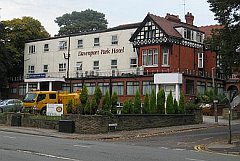
Ater World War II the house became, with a large extension, the Mile End Hotel, later renamed Davenport Park Hotel. The hotel was sold to new owners in 2014, and re-named 'The Davenport', before closing in 2017.
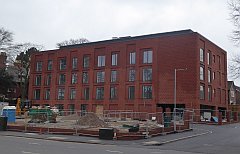
It has since been demolished and replaced by a block of 39 apartments, built in a red-brick style.
177 and 179
The pair of large semi-detached houses with tudor-style decoration 177 and 179 Buxton Road. was named 'The Orchards', Residents over the years included a number of important Stockport people:
Henry Sutton of hatting firm Sutton & Torkington, whose factory was in Lord Street, Stockport, was at 177 in 1893.
Frank Robinson, cotton manufacturer, single, with two servants, lived at no. 177 in 1911.
177 and 179 avoided the conversion to flats which many large houses suffered. The final private residents of 177 were Stockport-born Arnold Pickering and his family, who moved in to 177 in the 1950s and stayed until at least 1968. Mr Pickering (1909-84) was an accountant who also served as an Elder of the Christian Brethren church community which met at Crescent Road Hall in Stockport. A friend and fellow Elder was Professor F.F. Bruce of the University of Manchester.
Charles W. Macara (1845-1929), Managing Director of Bannerman's, cotton spinners of Manchester, apparently could be found at no. 179 in 1893, although this may not have been his permanent address.
Herbert Ernest Corbyn, Stockport's Medical Officer of Health, was living at no.179, unmarried, with one servant in 1911. He was the author of science textbooks for medical students; during World War I he joined the army and served as Medical Officer of Heath for Baghdad in 1917-18. He died in 1922.
Wlliam Bramley Lowe, born in Salford in 1888, was the son of a decorator. By 1911 he was working for the the Heaton Norris Council as a Surveyor's Clerk; probably he later continued his career with Stockport Council after it merged with Heaton Norris. He lived with his family at no. 179 from about 1950.
William died in 1962, and no. 179 had no electors in the 1965 electoral register; it had been left empty. His grandson has kindly prepared some notes for us: see the right-hand column.
No.185
No. 185 'Peak Lodge' was, from its building in 1892, the home of John Cash Arnfield (1858-1931), son of Mr. Joseph Arnfield, J. P. of New Mills, Derbyshire. He married Mary Eliza Dunkerley in 1882.
He served his apprenticeship with chemists Kay Brothers of Stockport; he set up his own business in Ashton-under-Lyne, until in 1887 he sold that shop and purchased the Stockport retail and wholesale business of Kay Brothers, who thereafter operated solely as a manufacturer of pharmaceutical supplies.
J.C.Arnfield & Sons, Ltd, Pharmaceutical Chemist and Druggist, operated from the Kay's former shop at 7-9 Lower Hillgate (later in Princes Street) and had a laboratory in Harvey Street.
Mr Arnfield lived with his wife, two sons Thomas Owen Arnfield and Harold Arnfield, and two servants at 5 Woodbine Crescent, Stockport until the new house at 185 Buxton Road was built; they named it 'Peak Lodge' as a reminder of John's former home town in the Peak District. After their son Harold moved out, John and his wife moved to a more modern house, 'Southwold' on Broadway in Bramhall. His wife died in 1930 and he died in 1931.
The next occupants of 'Peak Lodge' were William Edward Hamnett, who was in the painting and decorating business, and his wife Clara. They moved to 'Peak Lodge' from 'Erlsdene', Offerton Lane.
By the 1920s William had changed professions to become a solicitor. He died in 1931; Clara, who must also have been a woman of some standing as she is recorded in 1934 as a Borough Magistrate, stayed in the house, but had moved away by the time of her death in 1950. and was living at 37 Perseverance Street, Sale. No.185 was abandoned and left to decay.
Many years later, in 1969, it was purchased and converted after to a social club for the Ukrainians who had come to live during and after the war in the Stockport area, which still operates under the ownership of the Association of Ukrainians in Great Britain, founded in 1946, one of 28 branches around Britain. The club, which had previously operated in a building on Turncroft Lane; the Club remains at no 185 in 2018.
No. 187 & 189
No. 187, 'Greystead' was the home in 1911 of Jesse Ainsworth Stott, a member of the firm Stott & Son, architects and engineers who built many of the cotton mills in the Manchester region.
No. 189, 'Strathmore Lodge', was in 1911 the residence of James Smith, a Solicitor with a office at 39 St Petersgate. His family included his wife Stella, and his step-children Claudius Stephenson, Douglas Buchanan Stephenson and Norah Geraldine Stephenson. A few years later, both Claudius and Douglas died in action in the First World War.
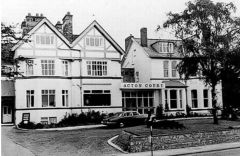
The two detached houses 187 and 189 were bought and converted to a hotel by Leslie Acton Tipping (1903-1989), a Manchester-born entrepreneur. He named it the 'Acton Court Hotel'.
The hotel was later run for 30 years from 1976 by Jack Trickett, a colourful character and boxing promoter who famously welcomed sportspeople, singers and silver screen superstars. He retired in 2007, and the hotel was sold to 'two un-named businessmen'
It is shown in the Google aerial view of that year, but closed in 2011 and was demolished soon afterwards, to be replaced (after some traffic-related issues with the planning authority) by a completely new building for the the 'Kids Allowed' nursery chain.
Contributions are very welcome at at info@davenportstation.org.uk

Tramcars never travelled along Bramhall Lane through Davenport, although Stockport Corporation did obtain Parliamentary powers to build such a line. They did, however, run for nearly half a century between Stockport and Hazel Grove along the eastern boundary of the area, a few minutes' walk down Kennerley Road. Photographs of trams on this section are rare; the view above, taken in the late 1940s by Frederick Noel Trevor Lloyd-Jones (1922-2011) who took many local tram photographs in the period post-war period. The entrance to Davenport Park estate is to the left of the white van, with Kennerley Road beyond.
The tram is Stockport Corporation's no. 75, the last of a batch of ten 56-seat cars built by Cravens in 1923; one of Stockport's most modern vehicles, although the basic design concept changed little in the 50 years that Stockport's electric trams operated. The first trams on the Hazel Grove route were horse-drawn, run by the Stockport and Hazel Grove Carriage and Tramway Company which began operating in 1890. In 1905 Stockport Corporation bought the company and converted the line to electric operation, and extended it to meet Manchester's line, allowing trams to run through between Hazel Grove and Manchester. Manchester Corporation tramcars shared this track with Stockport's.
The picture is full of interest. Note the double track in the centre of the road; in some places they rails are still there today under the tarmac. At stops, passengers had to make their way across between the other traffic on the road; hard to imagine in today's conditions. Following the tram is an Austin K-series delivery van of Rylands textile merchants, the firm founded by John Rylands, known today for the memorial library created by his widow. Sadly the name on the van to the left cannot be read.
The picture is not dated, but there are clues to be found. The white markings on the pole would have been painted to help pedestrians in the blackouts of the 1939-45 war. Tramway service to Hazel Grove ceased on 14 January 1950, by which time Manchester's tram lines had already closed and the route ran between Hazel Grove and the Manchester border at Crossley Road; perhaps the photographer was aware of the coming closure when recording the scene for posterity. Trams finally vanished from Stockport with the end of the Stockport - Reddish route on 10 April 1951, and No.75 survived until the end.
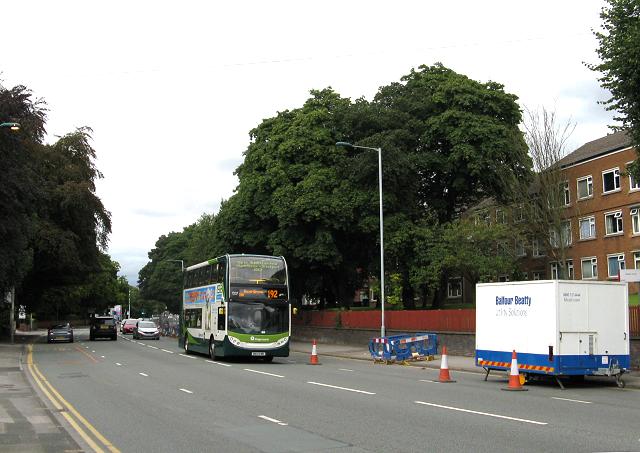
For our 2014 view of the same area we stood a little further back, in order to show what is behind the trees which are now very mature. The bus working route 192 Manchester - Hazel Grove is Stagecoach Manchester's no. 12213 (MX13 FNK) of Stockport depot a 77-seat Alexander Dennis 'Enviro 400H' Hybrid built in 2013. Hybrid buses have batteries which are kept charged by the diesel engine, and automatically provide extra drive power when required. This means that a smaller engine, running at a more more efficient constant speed, is needed.
The general background scene has not changed greatly except that the Private Hotel and several of its neighbours have been replaced by the Clifford Court housing development, seen on the right. This has a history of its own, which is worth relating.
181 and 183 Buxton Road
 'Sunnyside', No. 181, has only its sign and
gateway in the picture. A detached residence with 14 rooms
(not including bathroom and lobbies), it was the home of
John Smith, joint owner of Higher Hillgate mills, one of
Stockport's 'doubling' firms, specialising in 'fine gassed
yarns, heald yarns and sewing cottons. 'Employees: 450'
according to a 1914 listing.
'Sunnyside', No. 181, has only its sign and
gateway in the picture. A detached residence with 14 rooms
(not including bathroom and lobbies), it was the home of
John Smith, joint owner of Higher Hillgate mills, one of
Stockport's 'doubling' firms, specialising in 'fine gassed
yarns, heald yarns and sewing cottons. 'Employees: 450'
according to a 1914 listing.John Smith was living at 'Sunnyside' in 1911 with his wife Emma, daughter Ellinor, son John (29, partner in the firm) and general servant Minnie Humphries. The family had been there since the house was new in the 1890s, and it remained in the Smith family for many years. The residents in 1945 were Bessie Brown Smith and Kathleen Emma Smith. Shortly afterwards it was sold to Wesley Haddock, who converted it to the Sunnyside Private Hotel; His story and that of the hotel, continues below.

'Thorncliffe House', No. 183, was, at least until the 1920s, the home of Lincolnshire-born William H. Robinson, tobacco manufacturer, and his family. The firm of Robinson and Sons had premises in Stockport at 9 St Petersgate and in the Market Place. The company passed to his son Arthur Robinson, and was eventually taken over in 1936 by Gallahers.
In 1956 this house also became part of the Sunnyside Private Hotel.
Wesley Haddock and Sunnyside - by John Ratcliffe
Wesley Haddock, born in Winwick, Lancashire in 1899, grew up
at Barnes Convalescent Hospital in Cheadle, where his
American-born father was chief engineer. He bought
Sunnyside, 181 Wellington Road South, in 1947, and converted
it into an hotel, the 'Sunnyside Private Hotel'. We
are indebted to his grandson for the following notes about
Wesley's eventful life and times.The hotel became a popular place for commercial travellers, many of whom became regular guests, returning often. As well as catering for those who stayed overnight with bed, breakfast and an evening meal, there was also a side of the business that provided for Wedding Receptions and Funeral Parties. It turned out that the Hotel business was mainly run by Wesley's wife, Agnes Hilda Haddock, because Wesley had other business interests that needed to be attended to.
Wesley Haddock started his career by going to sea in 1915 as an apprentice cook and baker. Through the Great War, he served on ships crossing the Atlantic, bringing supplies and troops from the USA and Canada. After the War, he also served taking those troops back. In the early twenties, he also did several voyages past India and onward to Japan, calling in at many cities on the Asian coast.
In December 1922, he married Agnes Hilda Preston, left the sea, and became a Pastry Chef and confectioner at the Midland Hotel in Manchester. At some time around 1930, he bought a bakery and shop, and at some point between getting the bakery and 1947, he became the licensee at the Red Lion, Hazel Grove.
During World War II, because of his catering experience, he was asked to take on the management of a canteen for an engineering works, as well as his other business interests. This was seen by the Ministry of Supply, who were controlling such things during the war, as so successful that more work's canteens were put under his management, and at the end of the war there were seven canteens in this enterprise. The canteen at Cravens Engine Works stayed with him until he was taken ill, shortly before his death in 1960.
In 1947 he bought the large Victorian House, Sunnyside, at 181 Wellington Road South. This was converted into the Sunnyside Private Hotel. There were 10 bedrooms for guests, a dining room for guests, as well as two lounges, one of which was private. By the use of large partition doors, the two lounges could be opened into one large room in which parties for up to maximum of seventy people could sit for a meal.
In 1955 there was sufficient demand for extra accommodation that when the house next door, number 183, came up for sale, it was bought with the deal being completed as the year turned to 1956. At this point, it was decided that Wesley and Agnes's daughter Marjorie (my mother) would be brought into the business, with this extra family (Marjorie, husband William, and two children, John and Barbara) to live in part of the new house. Conversions were carried out to give an extra six bedrooms for guests, and a covered walkway was built between the two houses.
Number 183, the second house, was called 'Thorncliffe House'. As I recall, the previous owners had the surname McDermot. At the time of the sale, I believe there was only one resident, an elderly lady, whose family lived elsewhere in Stockport and they decided she could no longer live on her own, so she went into a nursing home. This house was built with staff in mind. There was a second staircase giving staff access to the bedrooms, and a butler's pantry, as well as a main kitchen, a scullery, and their own toilet and washroom. The house was wired for bells to call staff to the bedrooms, the two reception rooms, and the dining room. The dining room had a fully sprung dance floor, and was large enough to do it justice.
Both houses had extensive cellars, with cold slab storage, and substantial hooks for hanging game or other meat. There were laundry rooms, and storage for both coal and coke, with boiler rooms for the central heating.
At the rear of these two houses were extensive gardens, both decorative and for the kitchen. Behind 'Sunnyside' was a bowling green, which survived until some of that area was required for parking. There was also a substantial stable building with a hay loft. There were also two garages with wooden floors, one of which had a pit for doing maintenance. There was a legend about the house that it was where the first motor car to come to Stockport stayed, being garaged in the rear reception room, which had french windows that opened sufficiently wide to allow access. Behind 183 the lawn was of sufficient size as to accommodate a full sized tennis court, with concrete sockets for posts for the net. There was no surrounding fence for the court, so it was obviously only for recreational purposes.
In 1960, Wesley Haddock died after a period of several months being housebound due to illness. His health had been declining for several years, making it difficult to fulfill his commitments to the canteen business. After his death, the Hotel business carried on until 1969 when Agnes' health became such that she could no longer carry on, and the changes in the demand for commercial hotel accommodation suggested that closure was the best option, as the strain was also telling on Marjorie.
For such large and imposing houses, it is noteworthy that of all of the houses from Corbar Road to Mile End Lane, only Sunnyside had provision for vehicular access from Wellington Road. 177/179 had a stable block with a small yard which had access off Corbar Road.
William Bramley Lowe and no. 179 - by Mike Booth
I remember very little about my grandfather, William Bramley Lowe, as he died when I was two years old; My full name is Michael William Booth, the middle name after William Lowe.
Before moving to No. 179 Buxton they lived in St Lesmo Road in Edgeley after the war. As well as the two daughters mentioned above there was an older son, Brian Ashworth Lowe, who, by the time of the 1955 register, would have moved to London to train with the Post Office. He went into telecommunications and was laterpart of the team at Goonhilly in Cornwall that received the firsttrans-Atlantic satellite TV broadcast in 1962.
The younger daughter, Joan Mary Lowe, was my mother. She trained as a pharmacist and worked at various local pharmacies including Stepping Hill Hospital and the Co-op store on Chestergate. She and my father moved into 31, Davenport Park Road in 1959, purchasing it for the princely sum of £1900, and lived there for the rest of their lives.
179 Buxton Road was indeed left empty after William’s death in 1962 when his widow, Mary Lowe, and the unmarried daughter Jean Emily Margaret (always known as 'Peggy') also moved into Davenport Park Road at No 26. There are photographs of my brother and I in the grounds of the empty house in 1965/6. I believe it had been sold to the builders of Clifford Court who were waiting to get possession of No 177, but I don’t know this for a fact.
After Mary Lowe died in 1971, Peggy moved across to the other side of Davenport Station, buying a flat in Fircroft Court on Bramhall Lane. She was a teacher, and became headteacher at Heaton Moor Infants School which to her delight was using the very same buildings that her father William had worked in when they were council offices in the 1930s.
Brian Lowe also returned to Davenport toward the end of his life when he suffered from Alzheimer’s disease and moved in to the converted upper floor of my parents’ home in Davenport Park Road. Thus at the start of the new millennium all 3 of William Lowe’s children were once again living just a stone’s throw from Davenport Station.
Clifford Pott and his Court
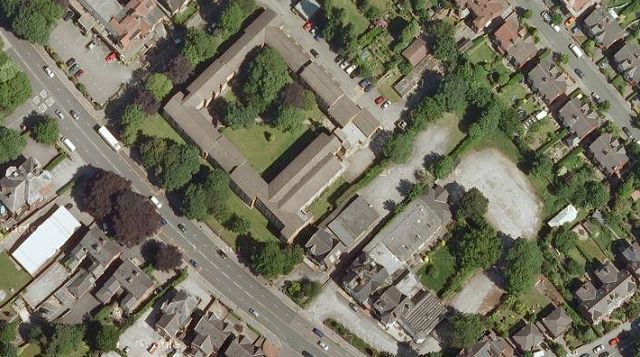
This Google view from about 2010 shows the large square of Clifford Court with its central gardens.
In 1963 Clifford Pott, who ran an Estate Agency in Disley, established - assisted by his wife Joy - North Cheshire Housing Association Ltd. Their aim was to provide decent, quality rented homes for local families and older people in housing need. Edward Barker, a Stockport solicitor, handled the associated legal work and the firm was based in Stockport at Barclay’s Bank Chambers, on the corner of Higher Hillgate and Wellington Road. Air Vice Marshal Johnnie' Johnson, the British fighter pilot and Second World War hero, was a friend and associate of Clifford. After his retirement from the RAF, in 1965, he and Mr Pott formed a business association which would see them working alongside each other, for the next 10 years or so.
Early schemes were based on co-ownership, but by 1968 North Cheshire had moved on to developing Housing Corporation funded schemes for rent, including Clifton Lodge in Davenport Park. The site of 177-183 Buxton Road was procured at this time for their most ambitious project to that date, Clifford Court, comprising 99 new homes, a mix of flats for rent and a 38-unit sheltered housing scheme.
In 1974, two flats in Clifford Court were converted into offices for Clifford Pott, Joy Pott, Johnnie Johnson, Desmond Oxley (Development Manager) and Gordon Hankinson (Accountant). In 1976, North Cheshire Housing Association and Johnnie Johnson Housing Trust went their separate ways; North Cheshire, which was expanding its operations to cover other parts of the country, relocated its headquarters to a large Victorian house not far from Clifford Court at 'Fulstone', 130 Mile End Lane, which became 'Fulstone House' and remained their headquarters until a move to Cheadle Hulme in 1998. (Mr Pott had retired in 1987.) In 2014 Fulstone House is a day centre offering treatment for individuals and their families affected by addiction.
Later projects in our area include Fulstone Mews (behind 'Fulstone'), Devonshire House in Davenport Park (1977), Swanbourne Gardens, Edgeley (for Pott's newly-formed Equity Housing Association), the conversion to housing of the former Royal Oak Brewery in Cooper Street (which took several years to come to fruition) and the nine properties for supported living plus nine shared-ownership flats on the site of the former Adswood Lodge in Stockholm Road, Adswood.
Information on Clifford Court is from '50 Years of Equity', available online as PDF, with thanks to the compilers of that very interesting booklet. (From April 2020 Equity became part of Great Places Housing Group.)
To School by Tram - by Mike Booth

This Stockport Corporation Transport 'Scholar's Voucher' was issued to my father, the late Leslie Booth, for travel by tram to and from and from school (he obviously failed to comply with the conditions on the back by returning it to the transport department on attaining the age of 17). He lived in Edgeley and went to Stockport School at Mile End, and the voucher allows travel, by tram only, between Greek Street and Woodsmoor Lane. It cost six old pence for his seven years of travel which sounds like a bargain even in those days.
He would therefore have been travelling on the tram route shown in the heading photo on this page, daily during school terms between 1942 and 1949, and at the end of this time, would have been passing on one side the house where his future wife was living (Joan Lowe at 179 Buxton Road) and on the other side the entrance to the road where they were to live for all but the first two years of their married life (Davenport Park Road).
Compiled by Charlie Hulme, 2015.
Updated April 2020.